Defenses for Spring 2013
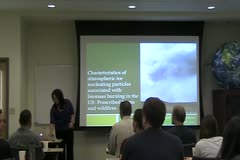
Characteristics of Atmospheric Ice Nucleating Particles Associated with Biomass Burning in the US: Prescribed Burning and Wildfires
July 08, 2013
Christina McCluskey
Insufficient knowledge about the sources and number concentrations of atmospheric ice nucleating particles (INP) leads to large uncertainties in understanding the interaction of aerosols with cloud processes, such as cloud life time and precipitation rates. An increasingly important source of aerosol in the United States is biomass burning, particularly in the form of prescribed burning and…
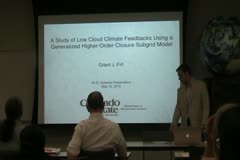
A Study of Low Cloud Climate Feedbacks Using a Generalized Higher-Order Closure Subgrid Model
May 15, 2013
Grant Firl
One of the biggest uncertainties in projections of future climate is whether and how low cloudiness will change and whether that change will feed back on the climate system. Much of the uncertainty revolves around the difference in scales between the processes that govern low cloudiness and the processes that can be resolved in climate models, a fact that relegates shallow convection to the…

Seasonal to Multi-Decadal Variability of the Width of the Tropical Belt
May 13, 2013
Nick Davis
An expansion of the tropical belt has been extensively reported in observations, reanalyses, and climate model simulations, but there is a great deal of uncertainty in estimates of the rate of widening as different diagnostics give a wide range of results. This study critically examines robust diagnostics for the width of the tropical belt to explore their seasonality, interannual variability…
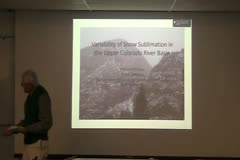
Variability of Sublimation in the Upper Colorado River Basin
May 09, 2013
Morgan Phillips
Snowpack stored in mountain environments is the primary source of water for the population of much of the western United States, and the loss of water through direct evaporation is a significant factor in the amount of runoff realized from snow melt. A land surface modeling study was carried out in order to quantify the magnitude of temporal and spatial variability of sublimation over a large…
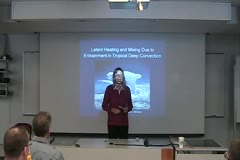
Latent Heating and Mixing Due to Entrainment in Tropical Deep Convection
March 26, 2013
Clayton McGee
Recent studies have noted the role of latent heating above the freezing level in reconciling Riehl and Malkus' Hot Tower Hypothesis (HTH) with evidence of diluted tropical deep convective cores. This study evaluates recent modifications to the HTH through Lagrangian trajectory analysis of deep convective cores in an idealized, high-resolution cloud-resolving model (CRM) simulation. A line of…
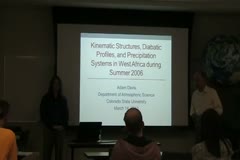
Kinematic Structures, Diabatic Profiles, and Precipitation Systems in West Africa During Summer 2006
March 14, 2013
Adam Davis
West Africa is a region characterized by great spatial contrasts in temperature, precipitation, and topography, which combine to create many complex and interesting weather phenomena. In particular, the area is home to a seasonal monsoon, propagating easterly waves, and some of the most intense thunderstorm systems on Earth. These types of events have both local and global effects –…

Characterizing the Influence of Anthropogenic Emissions and Transport Variability on Sulfate Aerosol Concentrations at Mauna Loa Observatory
February 20, 2013
Lauren Potter
Sulfate aerosol in the atmosphere has substantial impacts on human health and environmental quality. Most notably, atmospheric sulfate has the potential to modify the earthÂ’s climate system through both direct and indirect radiative forcing mechanisms (Meehl et al., 2007). Emissions of sulfur dioxide, the primary precursor of sulfate aerosol, are now globally dominated by anthropogenic…
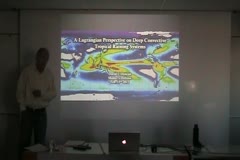
A Lagrangian Perspective on Deep Convective Tropical Raining Systems
February 15, 2013
David Duncan
Deep convective precipitating systems are categorized, tracked, and analyzed in the Tropical Ocean. Precipitating systems are tracked via an algorithm applied to the high-resolution CPC Morphing technique (CMORPH) precipitation product. Systems are categorized with an objective method, using data from the Tropical Rainfall Measuring Mission (TRMM) Microwave Imager (TMI) and a K-means clustering…
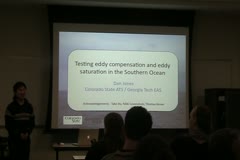
Testing eddy compensation and eddy saturation in the Southern Ocean
February 11, 2013
Dan Jones
The Southern Ocean (SO) is a unique and dynamic component of the climate system. Due in part to its cold temperatures and large surface area, the SO is an important region for the transfer of heat, momentum, and climatically relevant gases between the atmosphere and the interior ocean. The strong westerly winds above the SO help drive a powerful current (i.e. the Antarctic Circumpolar Current…
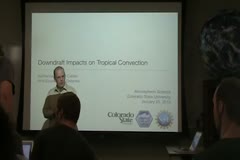
Downdraft Impacts on Tropical Convection
January 25, 2013
Katherine Thayer-Calder
Downdrafts are an integral part of the convective cycle, and have been observed and documented for more than a hundred years. But many questions still surround convective downdrafts and their most difficult to observe properties. These questions have made the parameterization of convective downdrafts in global climate models (GCMs) very difficult. Designers of parameterizations have resorted to…
